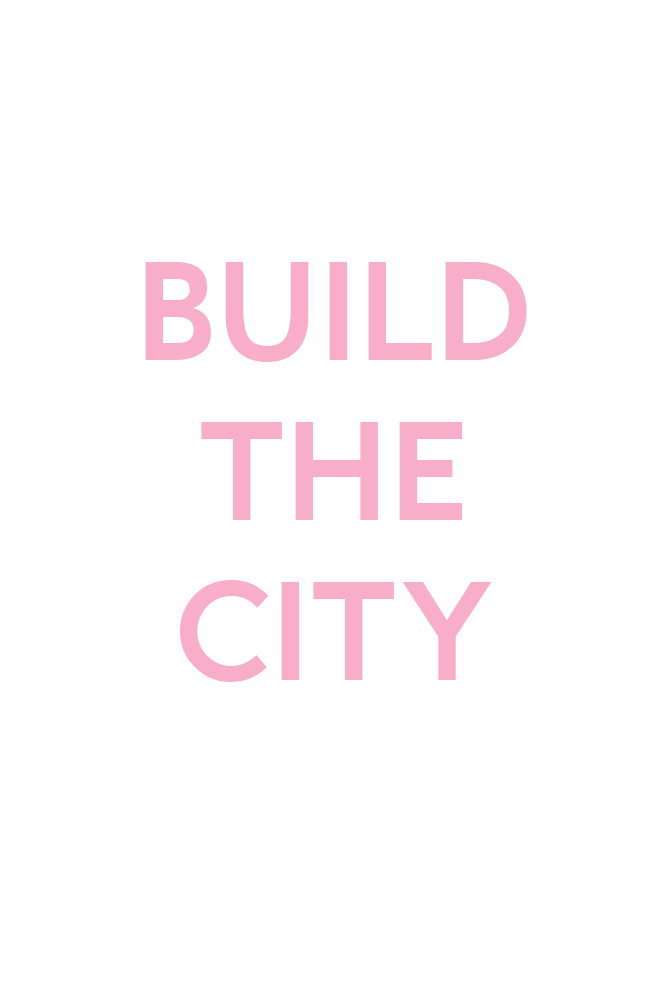
Build the City
A Strategic Idea for Leeds Southbank
The idea targets a City in Flux, identifying opportunities of intervention which enhance the public realm and animate space (1. Space).
Changing the perception of an area’s potential by responding to the needs and wellbeing of future occupants and neighbouring communities (2. Belonging). Supporting interventions by piloting innovative interim cultural and economic activity to secure local distinctiveness and influence long term legacy (3. Resources). Engagement provides learning and skills opportunity making the city accessible (4. Learning). Temporary occupation granted through licence, protects land owners and prevents stagnation. (5. Rules) Governance is re-imagined by the creation of a recognised area of immediate intervention – RAII
The proposition defines a neighbourhood by stimulating cultural activity with a ‘RIOT’ of interventions which build in intensity and scale to transform an area. Over thirty sites of ‘occupation’ are targeted to make the environment engaging and stimulating to residents, students, visitors and workers. A critical mass of sustained activity over time will encourage un-solicited participation through copycat action and entrepreneurial innovation.
This transformational guerrilla campaign will be given curatorial shape to ensure quality and cohesion.
The territory is under-utilised: vacated land under-developed but adjacent to the commercial centre. The idea proposes a strong culture-led identity for the area so that this becomes embedded in future development and influences any forthcoming large scale, top down initiative. The activities define a culture not to be ignored but to be nurtured, listening to native voices and stimulating local entrepreneurial innovation. The activity breaks down the area’s negative psychology and establishes mental and physical connections with surrounding neighbourhoods and the commercial centre. It proposes a locally-led, collaborative model for development that engages participants of all ages as active producers of their immediate environment. This links thematically to the area’s heritage of industrial production through the 19th and 20th centuries, characterised by collaborative worker-led processes of the mills, factories, workshops and breweries.
Mimicking trade zones and enterprise zones, the area would benefit from special planning and policy relaxations to stimulate activity and occupation. The project team will broker temporary occupation licences, protecting landowners’ benefits but a preventing their stagnation of land through inactivity. The territory would become a recognised area of immediate intervention – RAII
A key exemplar project is a temporary theatre located on land allocated to the proposed New Generation Transport scheme . The land allocated currently lies sterile and unused. The theatre would provide a stage for cultural charities working in adjacent deprived neighbourhoods bringing dance, music and performance from the community into the city centre.
The context of your idea
Large scale national and regional infrastructural change impacts local development. It creates uncertainty and stagnation in the short term as landholders wait for values to rise. Authorities are compelled to prepare visionary plans for large tracts of land to illustrate long term certainty and benefit. Big ideas, big buildings and large land uses often overwhelm, isolate or ignore cultural richness, diversity and distinctiveness existing within local and neighbouring communities which could influence lasting legacy proposals and drive distinctive active vibrant places. The opportunity exists to exploit the interim period between infrastructural change and development to nurture pilot projects focussed on communities, independents and entrepreneurs.
South Bank Leeds (Yorkshire), an area of proposed city expansion includes the site for the future High Speed Rail Two (HS2) transport interchange and a city scale park. The area has a number of heritage buildings a rich industrial past. and the legacy of previous infrastructure solutions.
The co-ordination of mass activity within a specific area and timeframe challenges existing modes of practice. We will explore how the master plan might be developed into that of a concept, managed /curated with on-going relationships to place-making, , defining space, public use and participatory involvement. Through this continuous activity we will identify sites for pragmatic adaptation/appropriation creating interventions that challenges boundaries of political engagement and aesthetic perfection.
Nurturing independent activity to create fringe cultural, artistic and innovative economic activity will sustain an active common ground resulting in a positive psychology and safer streets. The sustained activity will make the area accessible to individuals of all ages giving them an opportunity to build their city by placing participatory activity at the heart of the project.
‘The City must be formed from the culture of its residents; otherwise the city will begin to form its residents and become a tool that works against them.’
Hans Scharoun, Grundlinien der Stadtplanung 1946
Target groups
Identified groups impacted by and engaged in the realisation of this idea;
- Local residents of all ages
- Local communities, community groups and agencies/organisations that work with them
- New visitors, e.g. city centre shoppers not yet engaging with the area
- Local authority
- Commercial businesses in the area and city centre
- Land owners
- Future residents and businesses
- Cultural tourists using existing provision, e.g. Royal Armouries and The Tetley
- Growing student and teaching population based at rapidly expanding education campuses in the area
We will reach the identified groups through our existing and extensive network resulting from our collaborative cultural partnership. Pilot catalyst projects will announce an alternative approach; making a noise, resonating with co-conspirators and collaborators.